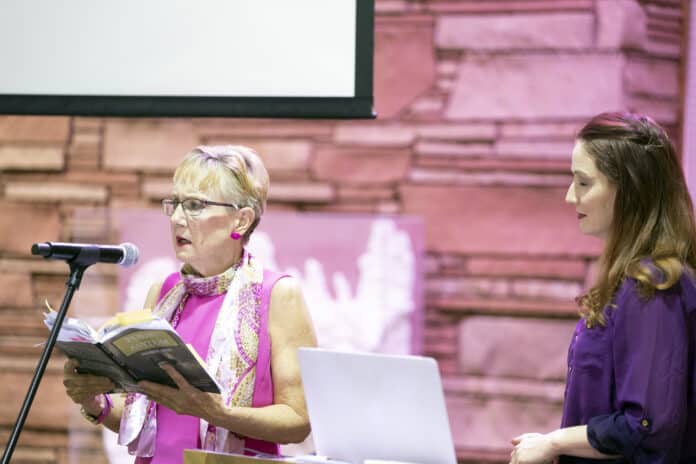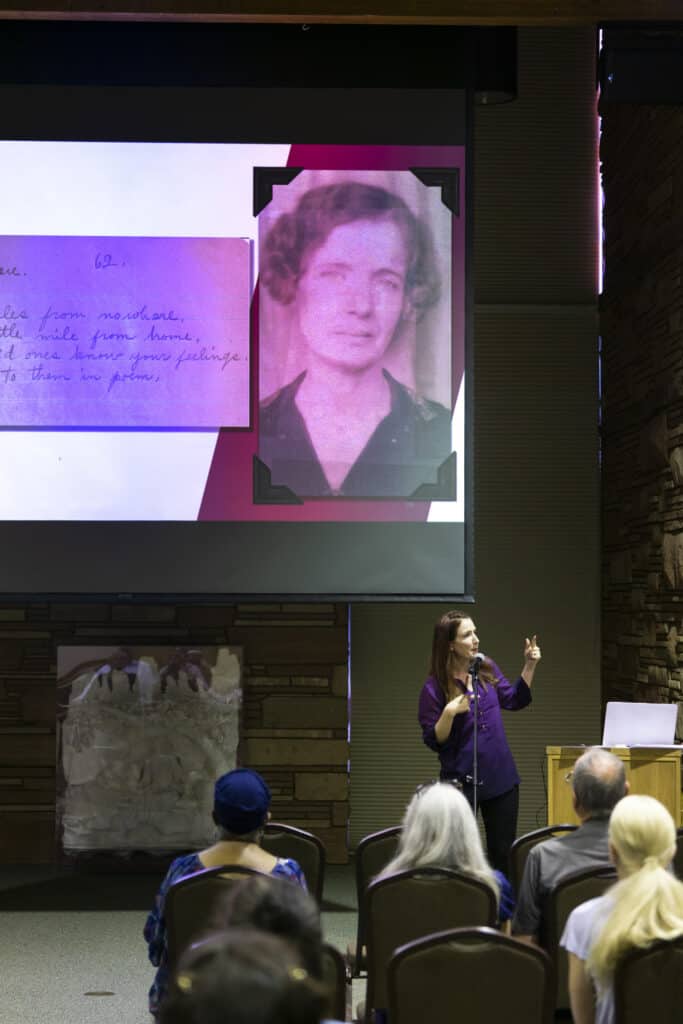
Telling the story of poet Martha Nasch [1890-1970] is a multigenerational effort for her granddaughter, Jodi Nasch Decker and great granddaughter, Janelle Molony. The mother-daughter duo discussed their self-published book “Poems From the Asylum” at the Sedona Public Library’s Si Birch Community Room on Saturday, June 24.
“From being in a place like this, of what you have to see … if you’re not insane when coming in, it won’t be long … you’ll be,” patient No. 20864 Martha Nasch wrote in her green composition book while behind the walls of the St. Peter State Hospital in Minnesota, where she remained from Jan. 29, 1928, to 1934.
“We don’t know how she came across the composition book, whether it was brought to her by a family member, perhaps the nursing staff provided it to her to give her something to do,” Decker said. “She documented her thoughts and feelings in this poetry journal. When my dad passed away, we inherited that along with photo albums and were able to go through all of that documentation.”
The journal containing her 80 poems remained in the possession of her only child, Ralph Nasch, until his 2019 death at the age of 98 in Mesa. Ralph brought the family to Phoenix in an effort to start anew. Molony described the six-month process of going through her work to create the book as heartbreaking.
“As we started to look up who this woman was, we saw a lot of negative press about her telling us that she was a liar, that everything she said was some kind of media show and she’s a total fraud,” Molony said. “We started knowing her based on whatever the press told us.”
Nasch’s story apparently began with a secretive medical procedure following the recent infidelity of her husband at the time, Louis J. Nasch, a painter. She alledgedly stated that her body did not feel or act the same way after the operation. The first symptoms Martha Nasch reported were an inability to eat, drink or sleep. The claim would lead to her being diagnosed with “a case of the nerves.”
Nasch would claim for the rest of her life that she no longer required food to survive. Her husband and relatives attested to that and her assertion led to Louis having her committed to an asylum.
“The doctor and the husband in agreement would sign a statement saying she needs to be committed,” Molony said. “She would have no say, she might not have been a participant in this conversation or have even gone to the doctor at all … and she’s forcibly removed from her home in January, in Minnesota.”
Nasch was released six and a half years later, but stood by her claims. Her husband was concerned with what his neighbors would think.
“He gets this idea in his head [that] the neighbors are talking or maybe the neighbors were gossiping,” Decker said. “He says I am very concerned that my neighbors are going to think I starve my wife. Louis takes it upon himself, he initiates a phone call to the local newspaper.”
The phone call would lead to a media sensation as scores of articles were written about Martha across the continent. The couple would eventually divorce after Ralph’s high school graduation and Martha went on to lead a quiet life until her death in 1970.
“She remarried a very nice man from a small town who made her a kept woman and she was happy to be in that kind of role,” Molony said.
“I don’t believe she resumed working other than just in the house. She died a little bit of a difficult death, we believe she had dementia. [But] … she ended her lifeon a sweet note surrounded by family.”
Molony advised people who are interested in researching their own genealogy that it can be a powerful experience that can help shape and fortify who they are as individuals to understand their ancestors’ struggles.
“My top piece of advice is — I call it the rule of threes,” Molony said. “Wait for three generations to pass. The original person you’re searching for, let them pass, because we don’t want to be exposing them in a way that’s going to offend.
“Wait for their children to pass, because when those stories come out, it’s potentially embarrassing for children. Also, children have rights to have their reputation not be marred by what might have happened by their parents. Then you wait one more generation [because] now you have no immediate family members who could potentially sue for slander.”
It is likely that a person could survive between 1 and 2 months without food, according to MedicalNewsToday.



















